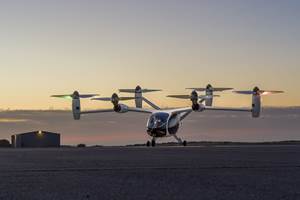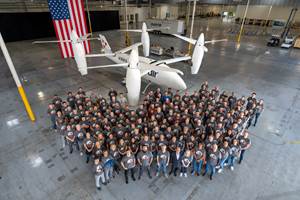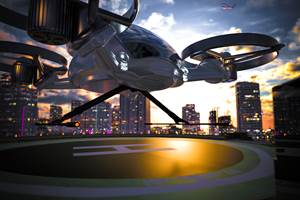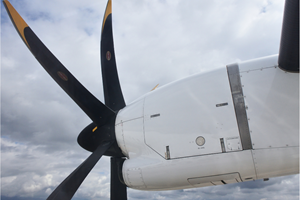NASA begins air taxi flight testing with Joby Aviation
The agency’s AAM National Campaign will apply what is learned about the composite eVTOL aircraft’s performance and acoustic date for future airspace concepts.

Joby’s eVTOL aircraft is pictured at the company's Electric Flight Base, located near Big Sur, Calif. Photo Credit: Joby Aviation
On Sept. 30 NASA (Washington, D.C., U.S.) began flight testing with Joby Aviation’s (Santa Cruz, Calif., U.S.) all-electric vertical takeoff and landing (eVTOL) aircraft (which recently hit range and noise targets) as part of the agency’s advanced air mobility (AAM) National Campaign. This testing runs through Sept. 10, at Joby’s Electric Flight Base located near Big Sur, Calif. This is the first time NASA will test an eVTOL aircraft as part of the campaign.
NASA’s goal is to collect vehicle performance and acoustic data for use in modeling and simulation of future airspace concepts. This test will reportedly help identify gaps in current Federal Aviation Administration (FAA) regulations and policies to help incorporate AAM aircraft into the National Airspace System. This multi-event campaign to advance airspace mobility in the U.S. will take place at multiple locations over several years.
“The National Campaign Developmental Testing is an important strategic step in NASA’s goals to accelerate the AAM industry timeline,” says Davis Hackenberg, NASA AAM mission integration manager. “These testing scenarios will help inform gaps in current standards to benefit the industry’s progress of integrating AAM vehicles into the airspace.”
During this round of testing, NASA will collect data from Joby’s eVTOL aircraft, which is intended to serve as a commercial passenger service in the future. Analyzing that data readies the AAM National Campaign to execute the first set of campaign tests, known as NC-1, slated for 2022, with more complex flight scenarios and other industry vehicles.
As the Joby aircraft flies planned test scenarios, the NASA team will collect information about how the vehicle moves, how the vehicle sounds and how the vehicle communicates with controllers. Future partners will fly similar scenarios to evaluate their vehicle readiness.
Moreover, the team will deploy the mobile acoustics facility and construct an array of more than 50 microphones to measure the acoustic profile of Joby’s aircraft in different phases of flight.
“NASA’s AAM National Campaign is critical to driving scientific understanding and public acceptance of eVTOL aircraft,” says JoeBen Bevirt, founder and CEO of Joby Aviation. “We’re incredibly proud to have worked closely with NASA on electric flight over the past 10 years and to be the first eVTOL company to fly as part of the campaign.”
Another element of the testing includes making sure external ranges participating in NC-1 meet the protocols for future testing by establishing a baseline to participate. The team will also test NASA’s flight safety and airworthiness processes to approve participants to fly in the campaign.
According to NASA, when fully integrated into the national airspace, AAM will provide an efficient and affordable system for passenger and cargo transportation, and other applications in the public interest. This system could include aircraft like package delivery drones, air taxis and medical transport vehicles.
The AAM National Campaign is managed by NASA’s AAM project, which plans to be a community catalyst for developing and validating system-level concepts and solutions for AAM. The AAM project is a part of the agency’s Aeronautics Research Mission Directorate.
Related Content
How composites have become a necessity
Composites used to be one of many material options across industries and applications, but that's not the case anymore.
Read MoreOverair completes assembly of full-scale Butterfly eVTOL vehicle prototype
Overair heads to flight testing in early 2024, marked by rapid prototype development.
Read MoreComposites opportunities in eVTOLs
As eVTOL OEMs seek to advance program certification, production scale-up and lightweighting, AAM’s penetration into the composites market is moving on an upward trajectory.
Read MoreWe're going to need a lot of propeller blades
As advanced air mobility expands and annual shipsets get into the thousands, the demand for composite propeller blades is expected to skyrocket. What are the implications for the composites supply chain?
Read MoreRead Next
From the CW Archives: The tale of the thermoplastic cryotank
In 2006, guest columnist Bob Hartunian related the story of his efforts two decades prior, while at McDonnell Douglas, to develop a thermoplastic composite crytank for hydrogen storage. He learned a lot of lessons.
Read MoreComposites end markets: Energy (2024)
Composites are used widely in oil/gas, wind and other renewable energy applications. Despite market challenges, growth potential and innovation for composites continue.
Read MoreCW’s 2024 Top Shops survey offers new approach to benchmarking
Respondents that complete the survey by April 30, 2024, have the chance to be recognized as an honoree.
Read More


























